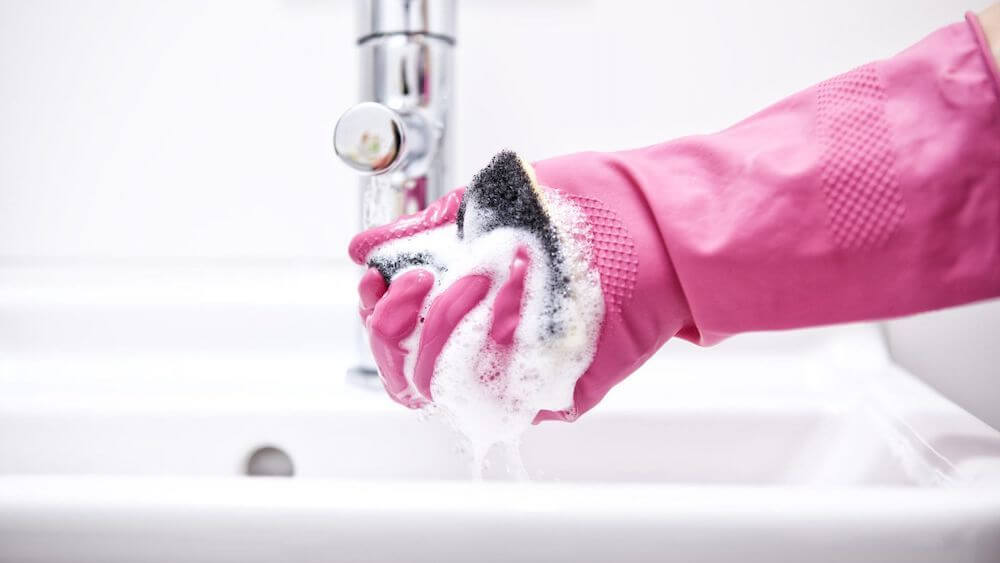It has taken many centuries to develop an awareness of bathroom hygiene, and sadly, even today in many places knowledge is still severely lacking. There is no underestimating the power of commercial restroom hygiene within the dynamic cosmos of modern business and industry.
The environmental odor and air freshening strategies of companies like Enviro-Master Pittsburgh have made their mark in establishing superior protocols for today’s commercial enterprises. Cleanliness is essential to the health, safety and the satisfaction of all users of public and commercial bathrooms. Nothing generates a bad impression among clients or demoralizes a company staff more effectively than a poorly maintained commercial restroom.
A clean company bathroom is rarely a topic of discussion by itself, but users will remember and talk freely about a dirty one! People who visit a bathroom that is clean aren’t likely to discuss it unless it features some extraordinary product or service, but if it is poorly maintained, the image sticks, and a company’s reputation can ultimately be damaged, if not ruined.
Logically, the train of thought is that a poorly maintained restroom translates into the message that this establishment doesn’t care about the health and well-being of its clients and employees.

A Short History of Poor Restroom Hygiene
Cleanliness is a relative concept in the historical context, as what was considered clean in centuries past would never be accepted as such in modern times. While the scientific advances of the last hundred and fifty years have brought about a true understanding of bacteria and the harm it can cause to human beings, the history of combatting bathroom filth is no sequential tale of the triumph of science over dirt. Truth be told, the more successful an economy, the more waste matter comes in its wake. Excavated from a London sewer, an inscribed bowl dating back to 1661 says it all: “You and I are earth.”
The ancient Romans introduced soap to the bathroom hygiene regimen back in 2800 BC. For many centuries, vinegar was the only available disinfectant, and weekly chores such as: dusting, polishing, rooting out foul odors, doing laundry weekly and washing hands and faces were believed to help maintain a tidy home and healthy, hardy residents.
And yet, since the Great Plague and closing of public bath-houses, 16th-century Western Europeans considered the submerging of the human body into bath water anathema. They believed that skin protected the body from disease and bathing risked the re-entry of toxins such as perspiration, menstrual blood, urine and feces into the skin through pores and orifices.
The social dilemma in those times was that one had to appear to be clean; a problem which was partially solved by changing body linens frequently. The linen rubbing against the skin absorbed the excreted toxins and were then thoroughly washed. A splash of bright white linen at the neck and sleeve were signs (or at least gave the impression of) good personal hygiene.
For centuries, residents of London and other large cities dumped their waste into brick-lined cesspits that would be emptied by the night soil men, who then either sold it as fertilizer or dumped it into the Thames. Liquid waste was also thrown out of windows and into gutters in the middle of the road. (Pity the poor passerby.)
Bathroom Hygiene In The Modern World
That old saying about beauty can also be used about dirt; that is, it is in the eye of the beholder. In Japan, for example, the toilets are always separate from the bathroom and the western tradition of blending the two in one room is offensive to Japanese thinking. The bathroom in Japan is considered an entirely separate part of the house and the toilet is always sunk into the ground, with a hood covering part of it to prevent water from splashing up when you flush. Bathroom etiquette in Japan requires family members and guests to take off their house slippers and use a pair of bathroom slippers when entering the bathroom and switch them upon leaving the area.
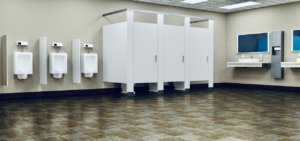
Psychologically speaking, in the world of retail, bathrooms represent the one space that most resembles being in a customer’s private home. A clean restroom in a department store, for example, communicates a silent understanding that the retail powers-that-be know what is important to their consumers. They can also passively demonstrate how certain products look within that designated location and how well they perform.
Hygienic bathrooms maintained by our teams at Enviro-Master Pittsburgh are the ultimate sign of retail hospitality, and their unspoken message to shoppers is that they are both welcome and important. Businesses that sell aesthetic materials, such as marble and granite, should feature these materials in their restrooms where they can serve as examples of how well they look and/or might work in someone else’s living or work space.
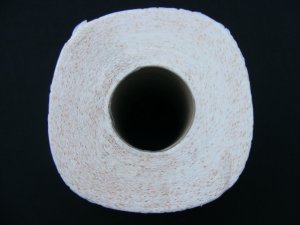
The Importance of Commercial Restroom Hygiene
According to a recent study, when asked what specific types of businesses participants would avoid if they encountered dirty restrooms, adults reported the following: restaurants-79%; hotels 79%; health care facilities-77%; supermarkets-50%; retail stores-45%; gas stations-45% and car dealerships-39%.
Another study entitled: Restroom Cleanliness Impacts Facility Perception indicated that 86% of adults in the United States equate the cleanliness of a restaurant’s bathroom with the cleanliness of its kitchen. Further indications concerned the fact that 75% of adults would not return to a restaurant with dirty restrooms.
A 2016 Harris Interactive poll, published in USA Today, demonstrated the impact of social media and online review websites. The survey indicated that 50% of people would discuss a dirty restroom with Internet friends and family. A bad review can have serious repercussions to a company’s traffic and bottom line.
10 Steps To Improve Your Business Restroom Hygiene
Restrooms take up 5% of the space of the average commercial facility, but contain 20% of the dirt and account for 80% of building complaints! Following these ten steps will ensure a cleaner, more hygienic restroom, a better company image and increased customer satisfaction.
1. Keep A Well-Equipped Arsenal of Tools
Enviro-Pitt has the best arsenal of cleaning tools available and their professionals know which are the best for each cleaning situation. The nature and number of tools change as the job gets more complex and range from special, microfiber cloths to restroom cleaning machines that can sanitize the restroom from ceiling to floor.
2. Properly Position Hand Hygiene Dispensers
Making soap dispensers readily available and fully stocked is vital to promoting good commercial bathroom hygiene. Keeping hands clean creates a healthy environment and prevents germs and bacteria from spreading to others. According to the Center For Disease Control (CDC), effective hand washing should take at least 20 seconds. Just applying a dab of liquid soap and running them under a little water doesn’t accomplish anything. The CDC also estimates that 80% of all infections are transmitted via our hands.
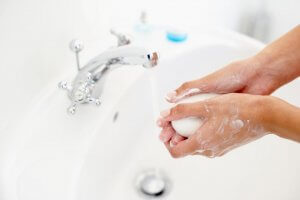
3. Provide Paper and Electric Hand Drying Options
A company bathroom should provide both paper and electric hand drying choices to accommodate customer preferences. The endless argument as to which is the more effective method may never be ascertained, as both have their virtues. Paper towels are known to spread less virus particles albeit most of them end up in the landfill, where methane, a greenhouse gas, is produced during decomposition. The process of converting the trees into paper towels and transportation consumes a lot more fossil fuels than hand dryers, which only require replacement after about 10 years of use.
The best option for lowest environmental impact is to use new, high-speed hand dryers, which cool the air and are more efficient than older models. According to The Slate, hand dryers are the greener choice in about 95 percent of circumstances. The Climate Conservancy reports that for each use, hand dryers cause between 9 and 40 grams of carbon dioxide emissions, whereas paper towels have an average of 56 grams of carbon dioxide emissions.
4. Instill Proper and Consistent Waste Management
Encouraging appropriate user behavior by providing a means of disposal for anything that might otherwise end up on the floor or clog toilets, is a vital consideration that facility managers and employers should never overlook. Installing water bins in every cubicle and adhering to a waste removal schedule helps to maintain a clean and tidy commercial restroom.
5. Provide Proper Female Sanitary Care
Facility managers and employers must make sure that safe and discrete hygiene solutions, such as providing sanitary bins and bag dispensers for female restroom users, are always available. Baby changing areas require customized hygiene treatments administered by the experts at Enviro-Pitt in order to avoid the spread of germs and harmful bacteria.
6. Use Odor Control Products That Contain Metazene
It is here perhaps even more than any other sector where Enviro-Master Pittsburgh surpasses its competitors. A service of any kind is only as good as the tools that come along with it, and this company’s odor combatting powers emanate from Metazene, the most effective odor neutralizing additive found anywhere in the world today. While there are many odor neutralizers in the modern marketplace, none work as well or better than Metazene. This dual action, colorless additive neutralizes malodors at a molecular level with a little help from industrial science.
Although it may seem to be some sort of magical intervention, Metazene’s powers lie in its simple ability to force a chemical reaction. The majority of odor neutralizers when confronted with residual or vaporous odors depend upon enzymes to produce a microbial action to eliminate foul odors. This usually results in only a temporary masking of bad smells.
Metazene’s powers of odor neutralization are superior because their molecules merge with foul odor particles, which linger in the air and are lighter in weight. This bonding alters their electron configurations and negates their properties via a series of chemical processes that include: hydrogen bonding, atom formation (adsorption) and encapsulation. The lighter molecules sink and evaporate over time due to very low vapor pressure.
7. Perform Routine Deep Cleans
All facility owners or managers in the Pittsburgh, PA area should hire professionals, such as our commercial hygiene care experts at Enviro-Master Pittsburgh, to incorporate a monthly deep clean as part of a restroom cleaning schedule. This process will include three major rules: clean from top to bottom; clean from wet to dry and work from the inside of the area or room towards the exit. This monthly routine is essential for it insures that areas that might be neglected such as: walls, grout, equipment and faucet taps, will not buildup grime and bacteria.
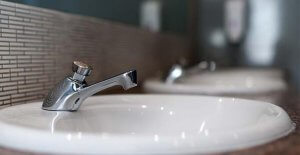
8. Go Touchless With Equipment
For many companies, the trend is to invest in touchless bathroom equipment. This can range from automatic flush systems, faucets and tissue and soap dispensers to auto-opening trash cans and and even doorways. According to Bill McGarvey, director of Training and Sustainability at Philip Rosenau Company: “The more touchless a facility can go, the better… These systems do a more thorough job of cleaning the restroom without putting cleaners in the position of having to touch surfaces no one else wants to touch.”
9. Never Neglect Restroom Hot Spots
According to Dr. Charles Gerba, an environmental microbiologist with the University of Arizona, the dirtiest bathroom spots are generally the floor, the outside of the sanitary napkin disposal container, the sink and the taps. He believes that any effective restroom-cleaning program must take into account the primary hot spots for germs and bacterial growth. These particular areas are those that are most often touched by human hands including: the door latch on the inside of the stall, the sanitary napkin box, the paper towel dispenser, the floor, the faucets and parts of the sink.
10. Keep Phones Out Of The Company Restroom
While this might seem like the violation of some inalienable right to communicate, it is really just a precaution suggested by Dr. Gerba who states that: “the average person uses their cell phone for two hours a day, so it’s very easy to recontaminate your hands and transmit the germs to yourself or someone else.” A recent study indicated that nine out of ten phones carried potential disease-causing microbes, and 16 percent of cell phones tested positive for fecal matter. In conclusion, leave your phone out of the commercial bathroom.
Enviro-Master Hygiene Solutions For Pittsburgh Businesses
We are a leading provider of commercial restroom services in Pittsburgh, Western Pennsylvania, Eastern Ohio and the West Virginia panhandle. Our repertoire of offerings include complete, deep cleaning restroom hygiene services, paper product programs as well as professional odor control and air-freshening strategies provided by our mother company, Air-Scent. We are a family-owned and operated business and are dedicated to the provision of optimum restroom hygiene services and products that are safe for the environment and destined to leave a minimal carbon footprint.
Our enduring reputation is marked by superior, cost-effective services that are destined to improve both company image and perception. No company manager or owner should ever underestimate the power of perception, for it is absolute reality for the particular customer who is unhappy with his or her individual company restroom experience.
Final Thought About Public Restrooms: I will never understand the bathrooms in this country. Why is it that the doors on the stalls do not come all the way down to the floor? -Seinfeld Show
Photo Credits: Pixabay

